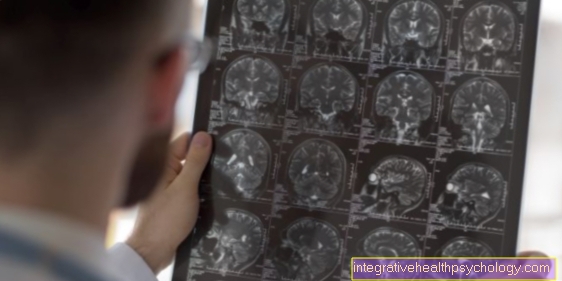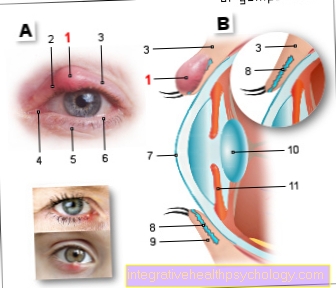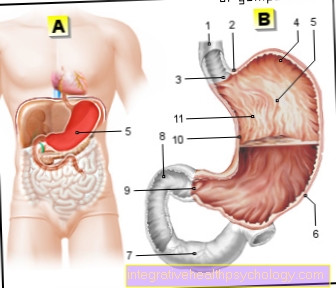Behavior therapy
Synonyms in a broader sense
Behavioral therapy, cognitive behavioral therapy, cognitive therapy, operant conditioning, operant conditioning, problem-solving training, self-management, social skills, attention deficit syndrome, psycho-organic syndrome (POS), ADD, attention - deficit - disorder, behavioral disorder with attention and concentration disorder, ADD, attention deficit disorder, dreaming ADHD Fidgety Phil, ADHD.
Fidget - Philipp Syndrome, Fidget Philipp, Hyperkinetic Syndrome (HKS).
Definition and description
After diagnosing problems or learning problems, such as the ADS, or the ADHD Primarily nothing has changed in the symptoms. This means that there is no way to rest on the diagnosis, rather the opposite is the case. It is important to adjust to the problems by means of multi-layered therapy (= multimodal therapy) in order to work out the best possible way of dealing with the clinical picture.
Often the problem already leads to further learning problems, such as reading and spelling weaknesses and / or arithmetic weaknesses. These problems can also occur if the child is gifted.
For this reason, an individual therapy plan should be created for the diagnosis as seamlessly as possible, which adjusts the different forms of therapy specifically to the individual symptoms.
One possible form of therapy is behavioral therapy with its various forms of treatment and treatment methods.
Behavior therapy
Behavioral therapy is based on the concepts of psychological learning and behavioral therapy and represents a Form of psychotherapy represent.
In contrast to depth psychology, in which the subconscious plays a major role, behavior therapy assumes that mental disorders are caused by incorrect learning, which is strongly influenced by defective reinforcement mechanisms.
The therapeutic approach can be complex. In general, a distinction is made between three main directions in behavioral therapy. These are:
- The classic behavior therapy
- The cognitive therapy
- Cognitive behavior therapy
Classical behavior therapy makes use of various learning principles, which should achieve the desired success through application, while cognitive therapy rather questions the perception and thought structures of the “patient”. Finally, cognitive behavioral therapy tries to combine the first two forms of therapy and thus to bring about specific changes in behavior through perception and thought structures, combined with specific learning and behavioral principles.
With regard to attention deficit disorder, this means that behavior patterns that are additionally reinforced by inconsistent parenting styles offer central starting points for behavioral therapy measures. Due to the inconsistent upbringing, the child does not experience any negative consequences, possibly even a reward, so that it can conclude that it gets away with its behavior. A child will then use these behaviors again and again, after all it has not experienced anything negative, possibly even something positive, as a consequence for its behavior.
These typical behaviors must first be examined in a problem-oriented manner. The central question to be asked is which situation triggers the typical behavior in each individual case. This behavior is then positively influenced by means of various behavioral therapeutic measures.
The measures described below represent various techniques / methods of cognitive behavioral therapy.
Operant conditioning

The operant conditioning, also called "learning through success" or "learning through success", is mostly directly associated with the name Skinner (B. F. Skinner) and his attempts with the so-called Skinnerbox.
The idea behind operant conditioning is that, in general, actions and behaviors to which a rewarding response occurs are repeated and, if repeated, can ultimately become a learned habit.
In operant conditioning, the learner is active because he controls his own behavior. He behaves in a certain way, either to get a positive reaction or to avoid negative consequences.
Reinforcers that lead to positive consequences are called "positive reinforcers". Those who lead to negative consequences, "negative reinforcers".
In the field of positive reinforcement A distinction is made between the following amplifier categories, for example:
- social reinforcer (praise, recognition, affection, positive emphasis, tenderness, ...)
- material reinforcers (material things like gifts, money, etc.)
- Action enhancer (actions that one likes to do can be performed (longer) or at all: longer games, excursions, ...)
- Self-reinforcer (the learner reinforces himself through social, material or action reinforcers)
Operant conditioning is particularly problematic when it is used incorrectly.
A simple example:
A child who achieves their desires by showing negative behaviors in public and parents reward that behavior by giving in. Imagine a child wanting to get certain candy or toys in a store. The mother negates this, the child literally rehearses a rebellion. In order to avoid the critical eyes of the environment, the mother fulfills the child's wish. If this happens more often, the child knows exactly:
I just have to rehearse insurrection to achieve my goal.
In the field of negative reinforcement A distinction is made between the following amplifier categories, for example:
- Unpleasant consequences ensue
- Pleasant consequences are withdrawn
- Pleasant consequences are expected from the agent but not carried out
There is also the option of behaviors no reactions to follow. You then promise yourself that a Delete the behavior occurs because there is no reaction or effect to it. A simple example of this would be to ignore the negative behavior of the agent in order to avoid these behaviors in the future.
Problem solving training
As the name suggests, problem-solving training aims to specifically solve everyday (and recurring) problems. There are different structures of problem-solving training, so-called problem-solving models, which are intended to promote the ability to recognize problems as such and to solve them through (alternative) actions.
In relation to the problem of attention deficit disorder, this means that the classic problem symptoms are analyzed and named. Together with the therapist, it is considered how one could react more appropriately to certain (recurring) problem triggers. This means that alternative strategies for action and solutions are created and determined. The conscious decision for a changed behavior should have the effect that the new strategy of action is first applied in the protected area, later naturally in everyday life. It is important to recognize many (different) triggering moments so that the transfer into everyday life can succeed.
Here you can already see that it makes sense to involve the parents as important caregivers of the child, as they (and the family as a whole) specifically support the application of new problem-solving strategies, and if necessary can also help.
Self-management training
The Self management training aims primarily to awaken readiness in the child problem something change to want.
This form of therapy tries to children initially playful to bring about negative behaviors that are known to them from everyday life and repeatedly cause conflicts to change.
Then with increasing age Strategies developed that enable ADD patients to to observe oneself, to discover incorrect behavior and to change it using the self-instruction technique. The self-instruction technique implies the ability to know and assess oneself so well that “own commands” lead to a change in the established behavior. If ... then - schemes are worked out and discussed so that the consequences of negative behavior can be seen. This also makes it clear that generally clear rules and consequences are formulated and adhered to in the home environment. Positive reinforcement is also important in successful self-management.
The Ideal shape is achieved when the patient has learned to assess his strengths and weaknesses and to come to terms with them. Only then is it possible for him to assess his own behavior and to foresee it in a certain way. “Dangerous situations” can be recognized as such and - ideally, intercepted through the ability of self-management.
Social skills training
The social skills training is also called TSK (= training of social skills) in the technical language and includes a therapy program that aims to treat social fears, phobias, depression, etc. This training aims among other things also depends on the achievement of skills, such as the ability for self-reflection, communication and (smooth) interaction with other people and the willingness to want to get in touch with other people. It is of particular importance to deal with one another with empathy, especially the peaceful resolution of conflicts, which is not always easy for ADHD children in particular.
An essential element of the social skills training is dealing with other people, especially in problematic situations. With regard to attention deficit syndrome both with and without hyperactivity, this means in particular that key situations that can trigger serious problems are recognized and named. Expressing feelings is particularly important in order to be able to determine suitable measures that can lead to alternative and less conflictual forms of action. This all happens first in the safe room, i.e. as part of the therapy, for example through role play, open discussions, etc. Together with the therapist, “new behaviors” that were discussed together are tried out and finally tried out in reality, for example in the home environment (family). Here, too, it is of particular importance that the family, especially the parents, are informed about the measures taken so that the therapeutic goal can be worked together and the behavior in the family environment does not have a counterproductive effect on therapeutic work.
Other forms of therapy
- General information on how to deal with the ADD child, including information for parents on the treatment of ADD.
- The drug therapy of ADD
- The nutritional therapy ADD with its different possibilities.
You can read more help from parents here: ADD and family, or ADHD and family. The therapy options mentioned complement each other in many ways. The treating physician or treating therapist can decide together with you which forms can be combined with each other in individual cases. It is important that the individual symptoms are taken as a starting point and a decision is made.
More ADD and ADHD topics
- ADS
- ADD causes
- ADD symptoms
- ADS diagnosis
- ADD therapy
- ADS curative education
- ADD psychotherapy
- Depth psychology
- Behavior therapy
- yoga
- Autogenic training
- ADD medication
- Methylphenidate
- Ritalin
- Antidepressants
- ADD diet
- ADD and family
- Educational games
- ADHD
- ADHD causes
- ADHD symptoms
- ADHD diagnosis
- ADHD therapy
- ADHD curative education
- ADHD psychotherapy
- Depth psychology
- Behavior therapy
- yoga
- Autogenic training
- ADHD medication
- Methylphenidate
- Ritalin
- ADHD diet
- ADHD and family
- Educational games
- ADHD curative education
Related topics
- ADHD
- Poor concentration
- Reading and spelling weaknesses / dyslexia
- Arithmetic weakness / dyscalculia
- Giftedness
A list of all the topics that we have published under our "Problems with Learning" page can be found at: Problems with learning A-Z





























